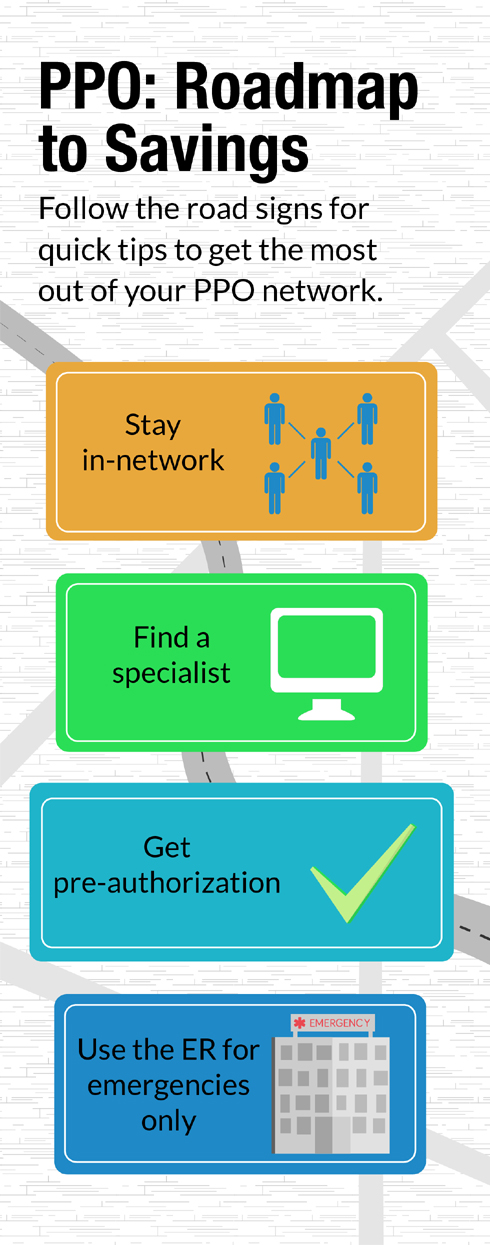Quick Links
What Is a PPO?

If you like having the flexibility to choose the doctors, hospitals and other health care providers you use to get care, and you can afford to pay more, a PPO may be the right plan for you and your family.
PPO stands for Participating Provider Option. It's a type of health plan that lets you choose where you go for care, without a referral from a primary care physician or having to only use providers in your plan's provider network. It typically has higher monthly premiums and out-of-pocket costs like copays, coinsurance and deductibles.
A PPO may be a good choice for you because:
- You don't need a primary care physician (PCP) to coordinate your care.
- You don't need a referral to see a specialist.
- You can get care from in-network or out-of-network providers.
Provider Network
A PPO plan has a certain group of health care providers you can use when you need care. This is called your PPO network.
Your PPO network may include care and services from certain:
- Doctors
- Hospitals
- Clinics
- Pharmacies
- Labs
- Imaging centers
- Medical equipment vendors
You can get care from providers not in your plan's network, but you will pay more for your out-of-pocket costs.
How do I know if a provider is in my network?
To make sure a provider is in your plan's network, search Provider Finder® ![]() , our online directory. Provider Finder allows you to see the doctors, hospitals and other providers who accept members in certain health plans. You can search by your plan name to see all the providers in your health plan's network, or you can search for certain providers you want to use, to see which health plans they accept.
, our online directory. Provider Finder allows you to see the doctors, hospitals and other providers who accept members in certain health plans. You can search by your plan name to see all the providers in your health plan's network, or you can search for certain providers you want to use, to see which health plans they accept.
Provider Finder also includes a cost estimator to help you find costs for general health visits as well as specific procedures, surgeries, diagnostics and imaging, vaccinations/ immunizations and other services.
If you're a Blue Cross and Blue Shield of Illinois (BCBSIL) member, register or log in to Blue Access for MembersSM, our secure member website, for a personalized search based on your health plan and network.
How to Use Your PPO
- You may need to get pre-authorization (or pre-notification) from BCBSIL before getting certain tests or services. Your doctor's office will call the pre-authorization number on the back of your BCBSIL member ID card to confirm. You can also call before you go for care or to confirm your doctor's office has gotten the needed authorization.
- For non-emergencies. For a common illness or injury, like a cold, flu, minor cut or burn, you have a few options to get care. These are less expensive than going to the emergency room.
- Call the 24/7 Nurseline. The number is on the back of your BCBSIL member ID card.
- Call your doctor. If the office is closed, call the doctor's after-hours number. They will either fit you into their schedule or refer you to another doctor or clinic. In some cases, they may have you go to the hospital.
- Visit a retail health clinic or urgent care center. Check Provider Finder to make sure the facility is in your plan's network.
- In an emergency — When your injury or illness is serious or life-threatening, call 911 or go to the nearest emergency room, even when traveling out-of-state or abroad. You won't have to pay the higher out-of-network deductible and coinsurance if it is an emergency.
- For specialist, behavioral health or hospital care. You do not need a referral to see a specialist or behavioral health care provider. You also don't need a referral to visit a hospital. You can get care from an in-network or out-of-network provider, but you will likely pay more for non-emergency services if you don't stay in network. To find in-network providers and hospitals, search Provider Finder®
 .
.
Helpful Hint — No matter which plan you have, before you need care, learn how your plan works, what's covered and where you can go for care. Knowing how your plan works may save you time and money. Learn more about Making Insurance Work For You »




